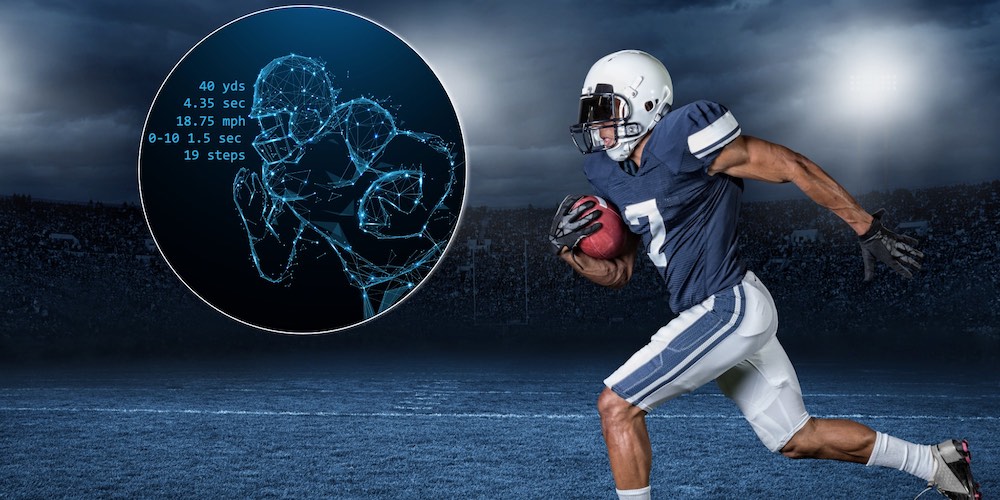What is the role of sportstech in player safety in American Football?

2022-02 With the Super Bowl being one of the biggest annual sporting events costing a hefty US$7 million for a 30-second commercial spot these days, the spectacle is garnering the interest of millions around the world and no longer only in the US. Besides cutting-edge broadcasting and fan-engagement technologies being deployed at the Super Bowl, the National Football League (NFL) is putting the same relentless pursuit of perfection into the betterment of player health and safety as the players themselves put into the game. This data driven revolution is using cutting edge technological advancements to help the league understand exactly how injuries are happening on the field.
Engineering Road Map
The NFL’s Engineering road map was a large-scale investment by the league in 2016 to better understand concussions within their game [1][2]. The goal was to improve the leagues understanding of the biomechanics of head injuries in professional football by hiring a number of biomechanical engineers with experience in the automobile industry. The NFL looked to model its efforts of injury prevention initiatives after those in the automotive industry as input for development of a method to allocate a 15-point performance score for helmets. These tests conducted on 5 different locations at 3 different speeds have been selected to emulate forces identified as they happen on field. For example, a crash test dummy with sensors in the head was used to measure the acceleration forces of the head resulting in what is nowadays referred to as the helmet performance score. As a result of that work, each year helmets are assessed in accordance with the helmet performance score and rankings published [3] following initiatives like the NFL Helmet Challenge [4] and the HeadHealthTECH Challenge [5]. Such initiatives have seen various advanced shock-absorbing materials ranging foams, gels to 3-dimensional lattice structures being explored.
Wearable Devices
Embedded within a players’ protective equipment, teams are making use of radio-frequency identification (RFID) tags or GPS devices. Through these tracking devices, data is collected on real-time location, speed, and acceleration for every player. However, it is a host of derivative statistics that can be calculated by combining and correlating all these data points with video footage which are then used for play-by-play analysis, game statistics and player performance. In addition, teams are developing analytical models to feed into strength and conditioning training, return from injury management and ultimately injury prevention or prediction. Combined with sensor data from mouth guards and helmets, on-field head injury and concussion assessment is the next frontier.
Athlete-Surface Interaction
Questions regarding sports shoe traction have dominated discussions about player safety when it comes to a measure of the static or sliding coefficient of friction between a weighted sports shoe and the turf pile surface due to horizontal motion. Whilst test methods, like ASTM F2333, have been used to determine the traction characteristics of the athletic shoe-sports surface interface, biomechanical testing devices, like the 'Biomechanical Elite Athlete Shoe Turf Tester’ (BEAST) have been used recently to replicate game-like interactions between a cleat and the surface in playing fields. In addition, the dynamic interaction between the athlete and the surface is significant to the performance and safety of the athlete. On the one hand, the ability of a sports surface to reduce the impact force of a body falling onto the surface is equally important as, on the other hand, the ability of the surface to deform under load. Accordingly, shock absorbing properties can be characterized as per ASTM F1936.

Fig. The instrumented player in American Football
Digital Twin
The large amounts of data and analytics open up new possibilities to model and simulate a digital athlete. The digital athlete is a virtual representation of a player using actual data derived from games. When combined with artificial intelligence and machine learning algorithms, the expectation is leveraging a digital twin to predict and eventually prevent injuries in athletes. Factors such as a particular game scenario, the environment, type of surface or the equipment worn have an impact a player’s performance and safety. On the one hand, historical data can also be leveraged to simulate and generate reconstructions of injuries that occurred on field and help the league, coaches and medical staff better understand why a particular player got injured. On the other hand, with the digital athlete used to simulate an infinite number of play scenarios, games or even seasons, could ultimately allow for better prediction and prevention of injuries. Whether such insight might require adjustments to training regimes, game schedules or even necessitates rule book changes in the future remains to be seen.
Additional information
If you are interested in specific technologies currently available in advancing player health and safety, please contact chemneera.
References
[1] National Football League (NFL). Engineering Roadmap
[2] National Football League (NFL). Player Health and Safety - Engineering Roadmap (downloadable factsheet)
[3] National Football League (NFL). Helmet Laboratory Testing Performance Results (2021)
[4] https://www.nfl.com/playerhealthandsafety/equipment-and-innovation/innovation-challenges/nfl-helmet-challenge
[5] https://www.nist.gov/speech-testimony/head-health-challenge-preventing-head-trauma-football-field-shop-floor-battlefield



